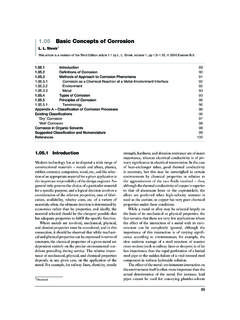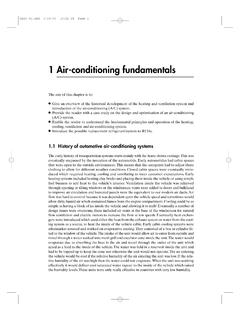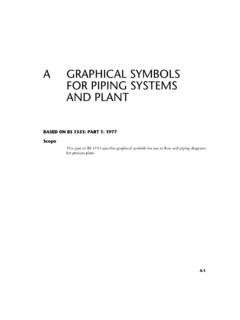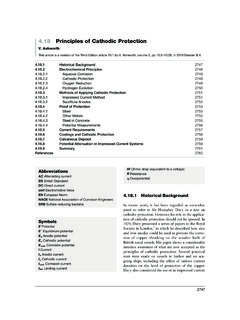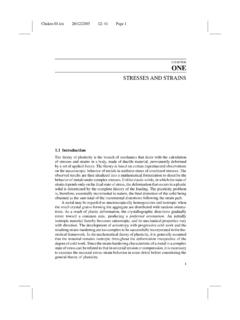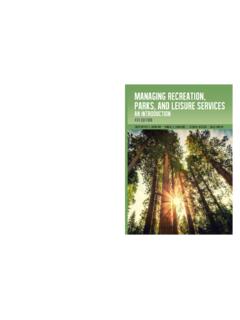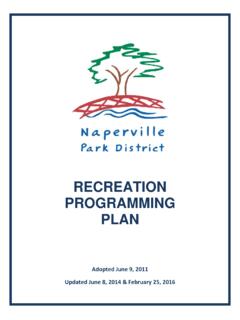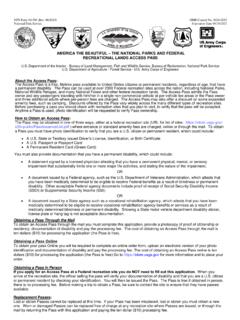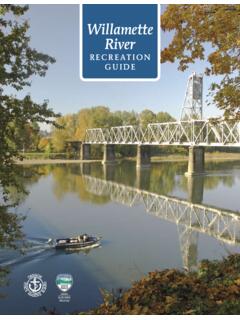Transcription of Water-Based Tourism, Sport, Leisure, and Recreation ...
1 6/11/06 6:56 PM Page 1. 1I. Water-Based Tourism, Sport, Leisure, and Recreation Experiences Gayle Jennings At the commencement of the twenty-first century, a wide range of niche tourism, sport, leisure, and Recreation experiences provide tourists, sportspersons, people at leisure, and recreationalists with substantial choices for how to spend their non- work time. Such niches include adventure tourism, sport tourism, recreational tourism, event tourism, marine tourism, national park tourism, and sun, sea, and sand tourism. Additionally, choices in sports range from easy to extreme, low to high impact, individual to team pursuits, casual to committed participation, mod- est to sophisticated equipment usage, and from relatively inexpensive to expensive setup and participation costs. Likewise, leisure and Recreation experiences provide a range of choices. To add to this diversity, tourism, sport, leisure, and Recreation can be undertaken in various environments, such as subterranean, terrestrial, Water-Based , aerial, outer space, and virtual environments as well as combina- tions of these.
2 Diversity is also a constant in regard to the various roles for engag- ing in these experiences. People can be participants, spectators, umpires, referees, coaches, support and service providers, organization/association officials, or vol- unteers. Moreover, participation can be described as active, passive, or vicarious. In contemporary times, the nature of participation in niche tourism, sport, leisure, and Recreation is influenced by a number of factors, such as time, finances, family life cycle, and participants' perceptions of skill, risk, novelty, adventure, and challenge. Previously, in the first half of the twentieth century, gen- der, ability, ethnicity, socio-economic, and cultural background were substantive limiting factors along with social, religious, and political influences. Prior to that period in industrialized nations, socio-economic class, gender and religion were strong differentiating factors.
3 Contemporaneously, the influence of these last two sets of factors has been reduced or removed, albeit some continue to exist as will be evidenced in the following chapters. 6/11/06 6:56 PM Page 2. Water-Based Tourism, Sport, Leisure, and Recreation Experiences Why a Focus on Water-Based Tourism, Sport, Leisure, and Recreation Experiences? Various books have been written about sport, leisure, adventure and tourism (see for example, Turco, Riley, and Swart 2002; Hudson 2003; Swarbrooke, Beard, Leckie, and Pomfret 2003; Weed and Bull 2004; Higham 2005) as well as tourism, recre- ation, and leisure (see for example, Veal 2002; McCool and Moisey 2001; Gartner and Lime 2000). In addition, a number of books have focussed on marine tourism (such as Orams 1999; Garrod and Wilson 2003), and several have highlighted cruise tourism (Cartwright and Baird 1999; Dowling 2006). Few, however, have focused specifically on water-oriented experiences across the broad fields of study of tourism, sport, leisure, and Recreation .
4 Furthermore, few, if any, have substantively addressed a variety of Water-Based experiences associated with a stable, albeit moving and movable, platform. As a consequence, this book turns the spotlight onto Water-Based experiences associated with some form of platform. Specifically, the book considers the Water-Based experiences of sailing, motor boating, motorized sports, surfing and windsurfing, sport and big game fishing, white-water rafting, kayaking, one-day boating adventures, sail training adventures, as well as scuba div- ing, free diving, and snorkelling, albeit that these latter three do not necessarily always associate with a platform. However, since boats are usually used to access a large number of dive and snorkelling sites and scuba divers may use underwater scooters and submersibles to access dive sites, scuba diving along with free diving and snorkelling are included in this volume.
5 Additionally, given the extensive liter- ature that has amassed in regard to cruise tourism, it is not included in this book. Finally, some readers may wonder why the term marine was not used. Several authors have addressed marine tourism. Elsewhere, references have been made to water tourism (Kedrow 1987; Ministere de l'Industrie, des Postes et Telecommunications, et du Tourisme 1987), river/canal tourism (Panne 1990;. Holloway and Plant 1993), nautical tourism (Laca 1996), marina-based tourism (Smith and Jenner 1995), and, more recently, lake tourism (Hall and Harkonen 2006). Apart from water tourism, the remaining terms tend to categorize by location rather than by overall resource base and related experiences. As a consequence, draw- ing on the term water tourism, for the intent of this book, the phrase Water-Based tourism, sport, leisure, and Recreation experiences has been coined.
6 In doing this, recognition is given to the overlap among tourism, sport, Recreation , and leisure as well as to the diversity in water resources that may be used for the former. Such water resources include salt, estuarine, fresh, and frozen water in their various formations. Background Within Western nations, water has long been associated with restorative qualities and medicinal benefits to balance the ardor of work, life in the city, or the pollu- tion inherent in industrial/urban areas. This association is evidenced in past prac- tices of picnicking beside creeks, rivers, and lakes; short excursions to lake areas, thermal springs, and the seaside; the taking of seaside holidays and vacations; sec- ond-home ownership by lakes, or at the seaside; and bathing and spa therapy as well as taking in the waters and fresh or sea air. 2. 6/11/06 6:56 PM Page 3. Water-Based Tourism, Sport, Leisure, and Recreation Historically, early European engagement with Water-Based activities and experi- ences can be linked to earlier Roman habits.
7 For example, the attraction of the seaside and seaside second-home ownership can be proffered to have its roots in early Roman practices. Ryan (2003) suggests that during the summers, upper-class Romans would relocate to their homes by the sea to escape the heat and the city. Similarly, the prac- tice of taking the waters aesthetically, physically, and spiritually is also linked to Roman practices, particularly the Roman baths (Knappett 2003). With the onset of the industrial revolution and subsequent developments in working conditions, such as shorter working days and public holidays, discretionary income, along with the con- current development of transportation technology, the lower-middle and working classes were able to experience to differing degrees the recreational and leisure pur- suits that had previously been the purview of the upper-middle and upper-class ranks.
8 For example, toward the end of the eighteenth century in England, spa towns, previ- ously the realm of the upper class, were inundated with lower-middle class populaces. Subsequently, the popularity of spa towns for the upper class waned by the turn of the nineteenth century and was replaced by an attraction for seaside resorts the pre- ferred location used by royalty particularly Brighton (Jeans 1990). The attraction of the seaside was also sponsored by the medical profession, which promoted the bene- fits of seawater. Again, the upper-class exclusivity of seaside locations changed with the development of railways, which served to make the seaside accessible to the work- ing classes. However, until around 1920 in England, trips to the seaside were prima- rily just that trips to the seaside being beside the sea rather than in it (Jeans 1990). For some, this earlier trend was still the case in England in 1984 when only 25% of visitors entered the waters (Ashworth 1984).
9 While not a popular activity in England, sea-bathing was a favorite activity in early New South Wales, as Australia was then called. However, due to religious cen- sure, sea-bathing was banned in 1833 and again in 1838 to protect social and moral values (Jeans 1990; Craik 1991). Subsequently, people were limited to using the seaside for promenading, picnicking and paddling (Art Gallery of New South Wales 1982, p. 4). Australian seaside resort practices exhibited a strong similarity to English seaside practices. Later in Australia, in the states of Victoria and South Australia, bathing machines were established to enable morally acceptable sea- bathing practices (Jeans 1990). Bathing machines enabled people, for a cost, to change from their everyday clothes into bathing clothes and also to discreetly enter the sea. Such machines were also used in England. Traditionally, in England, seaside resorts and activities were used as a break from normal routine, whereas in Australia, due to settlement trends, particularly along the eastern seaboard, seaside resorts were integrated into urban centers.
10 Consequently for Australians, beaches have been a way of life (Wells 1982). For most Australians, the beach has been close, cheap, and easy to get to (Craik 1991, p. 45), and able to be experienced by all social strata. That being said, in Australia, proximity to the seaside was not always enough to satisfy Water-Based sporting, recreational, leisure, and tourism needs. People began to quest for different and less populated settings as well as different expe- riences. As a result, seaside resort experiences close to urban precincts began to be complemented by more expansive sun, sea, and sand experiences under- taken in remote locations. In addition, fishing was added to the traditional seaside Recreation experience mix of going to the beach and swimming/bathing (Fabbri 1990, p. 263). 3. 6/11/06 6:56 PM Page 4. Water-Based Tourism, Sport, Leisure, and Recreation Experiences An illustration of this can be drawn from the Great Barrier Reef.

